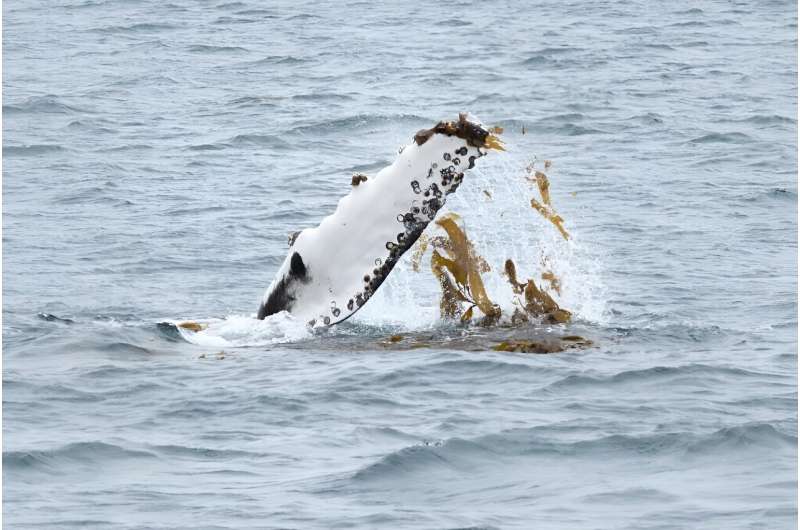This article has been reviewed according to Science X's editorial process and policies. Editors have highlighted the following attributes while ensuring the content's credibility:
fact-checked
peer-reviewed publication
trusted source
proofread
Migrating humpback whales around the world seen rolling in and playing with seaweed

First it was a sandy skin scrub, now it's been reported that migrating humpback whales are using seaweed to play with and roll in, according to new research.
Griffith University's Dr. Olaf Meynecke, from the Coastal and Marine Research Center and Manager of the Whales and Climate Program, has previously documented whales rolling in sandy substrates off the Gold Coast, Australian coastline as a possible way of removing dead skin cells and parasites during their migrations.
However, a new paper from Dr. Meynecke has analyzed another understudied behavior in baleen (filter-feeding) whales such as humpback whales in different populations across the northern and southern hemispheres. They appeared to roll around and "play" with clumps of kelp and seaweed at the water's surface.
The study, "What's at Play: Humpback Whale Interaction with Seaweed Is a Global Phenomenon," published in the Journal of Marine Science and Engineering, also emphasizes that the behavior was similar in different individuals, regardless of where in the world it occurred.
Dr. Meynecke analyzed three instances of "kelping" on the east coast of Australia derived from aerial observations, as well as 100 documented interactions with seaweed from around the world.
These interactions included 163 baleen whales, with humpback whales the most prevalent (95 separate events), gray whales (2), southern right whales (2) and northern right whales (1).
Adults formed the largest group of documented interactions (53%), then calves (14%), subadults (1%), and unidentified sizes (32%).
"The use of objects by cetaceans like baleen whales is well known, and their ability to interact with their environment in complex behaviors has been previously reported on," Dr. Meynecke said.
"But baleen whales, including humpback whales, are less often observed to perform object use, and this behavior might be more common than previously thought.
"There are two plausible theories: play and/or self-medication with seaweed. This behavior may be playful but could also serve additional benefits in the context of learning and socializing, as well as ectoparasite removal and skin treatment by using brown algae's antibacterial properties."
Dr. Meynecke said identifying this type of behavior across different populations was important to better understand the species' habitat preferences and underlined the complex behaviors whales displayed that scientists still had much to learn about.
More information: Jan-Olaf Meynecke et al, What's at Play: Humpback Whale Interaction with Seaweed Is a Global Phenomenon, Journal of Marine Science and Engineering (2023). DOI: 10.3390/jmse11091802
Journal information: Journal of Marine Science and Engineering
Provided by Griffith University


















